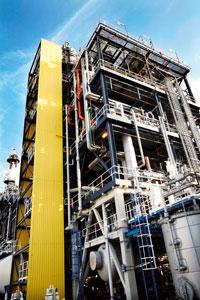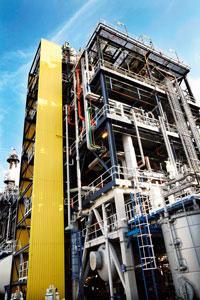The gas exiting the acid gas removal unit enters a gas dehydration unit, where any remaining water molecules are removed. This ensures that no hydrates form in the gas, as it will eventually be subjected to cryogenic temperatures in the downstream process.
Absorption
One of the most commonly used methods to dehydrate natural gas is absorption using a physical solvent, such as glycol, in the absorber. Water is highly soluble in glycol and dissolves into the glycol stream when it comes into contact with it. There is a range of different glycols that can be used, but triethylene glycol (TEG) is most typically used. The feed enters an absorption column from the bottom stage, while the lean glycol enters from the top stage. These two streams come into contact in the column, and water molecules and some trace amounts of hydrocarbons dissolve into the glycol stream from the natural gas. Dry gas exits through the top of the absorber column. Consequently, the now water-rich glycol exits from the bottom stage and enters a valve to depressurize the stream so the dissolved hydrocarbons are removed once the stream enters a flash tank. The water-rich glycol is then heated by a heat exchanger before it enters a still. It is then heated by the reboiler at glycol’s regeneration temperature of 204°C. Regeneration of glycol occurs when the water is removed from the glycol in the form of vapor that exits from the top of the still. The hot regenerated glycol exits through the bottom of the still, then passes through a series of heat exchangers to cool it back to the temperature of the absorber so it can be recycled.
Molecular Sieves
Similar to the molecular sieves in the gas sweetening unit, these materials are also used as an extra step in the absorption unit to further remove water molecules that the absorber column is not capable of removing.
Acknowledgements
- Alfa Laval
References
- Mokhatab, S.; Poe, W. A.; & Mak, J. Y. Handbook of Natural Gas Transmission and Processing. Boston: Gulf Professional Publishing, 2015, 191-217
- Kidnay, A.; Parrish, W. Fundamentals of Natural Gas Processing. Boca Raton: CRC Press, 2006
- Carroll, J. Natural Gas Hydrates – A Guide for Engineers; 3rd ed.; Elsevier, 2018.
- Engineering data book: volumes I & II: SI version; Gas Processors Suppliers Association: Tusla, OK, 2012.
Developers
- Nuramani Saiyidah Binti Ramli


